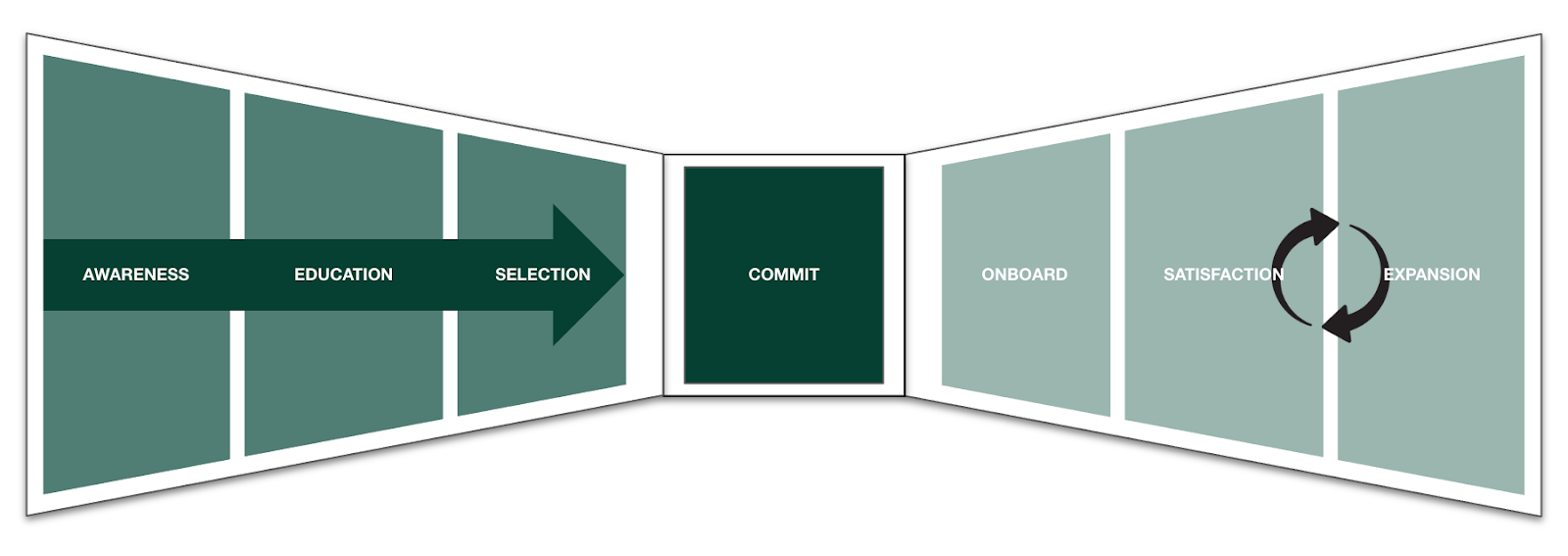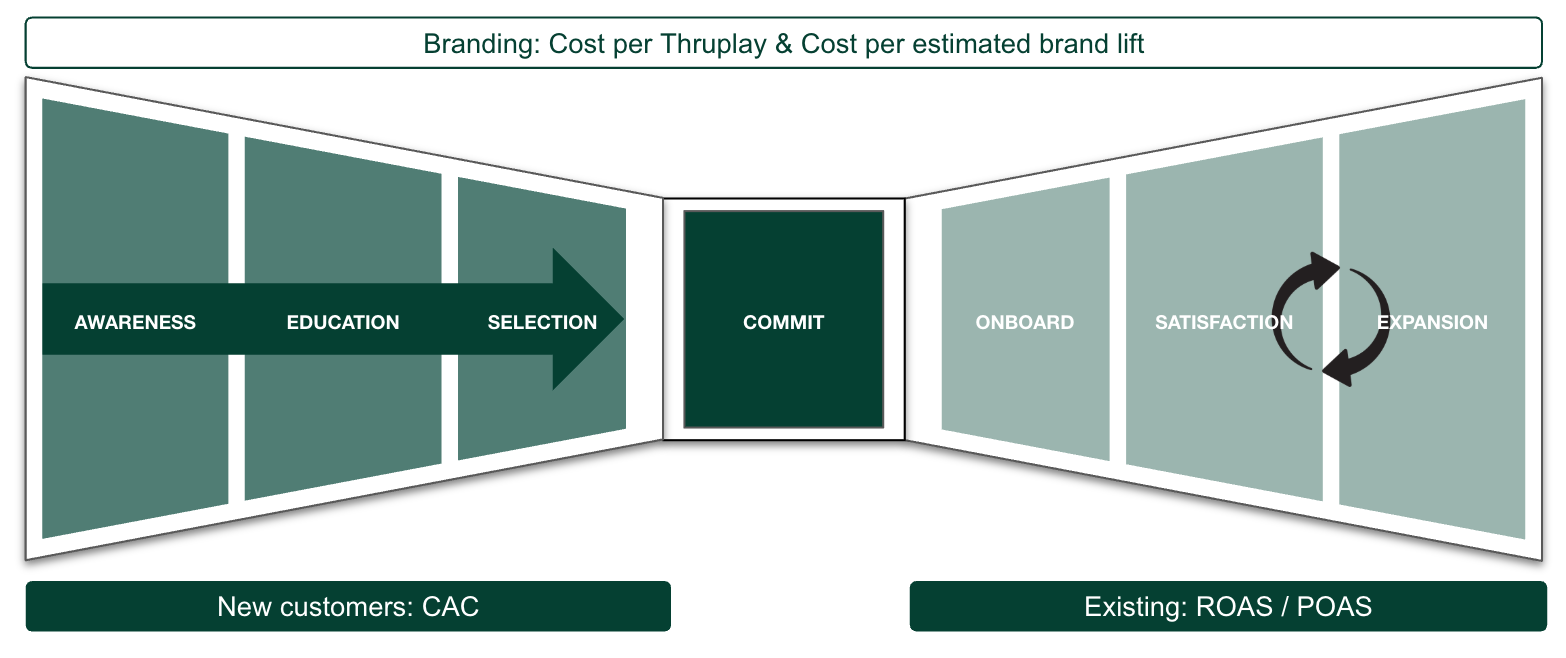
.png)
Paid social is getting pricier, cookies keep crumbling, and every new CLV forecast seems to shrink the further out you zoom. Yet most D2C brands still run their marketing like a one-way funnel: Drive traffic, convert, repeat. The result? They celebrate a first sale and then sprint back to the media platforms, leaving profitable expansion revenue on the table.
Revenue marketing flips that script by owning the entire customer relationship, not just the acquisition efforts.
In this post we’ll borrow a framework long loved by B2B teams, the bowtie model, and retrofit it for ecommerce brands. By the end you’ll know:
Revenue marketing is a discipline where every tactic (creative testing, landing-page CRO, email automations, etc.) is engineered against a single outcome: Predictable, compounding revenue.
It differs from classic performance marketing in three ways:
Those principles matter because up to 80 % of the value created by leading growth companies already comes from existing customers (source).
Keep that stat in mind as we meet the bowtie!
Picture a funnel that pinches in at the sale and then widens out again. That’s the bowtie (see model below). The first half looks familiar: Awareness → Education → Selection. The second half forces you to keep going: Onboard → Satisfaction → Expansion.

Retention trumps acquisition: Acquiring a new customer can cost up to five times more than keeping an existing one (source).
Secondly, small lifts, big profit: A 5 % increase in retention can raise profit 25-95 % according to Bain & Company (source).
Experience pays: Companies that orchestrate proactive post-purchase journeys generate 20-30 % higher retention than those that don’t (source).
If you are burning budget on Paid Social acquisitions while ignoring these compounding gains, you are fighting gravity.
On the right side, POAS beats classic ROAS because repeat-order margin is king. Two buyers on identical revenue can have wildly different profits once you add variable fulfilment or wholesale cost. However, that’s no news.
What might be for some, is the removal of ROAS / POAS on the left side of the model. That’s simply not a value metric for this segment. We can’t treat our new and existing customers the same, thus we can’t evaluate them using the same metric either. Therefore, we switch to measuring new customers and CAC as the new North Star.
Also, we can’t forget about branding. Despite it being a heavy player in the awareness and education, it has a role to play across the entire funnel - just different messaging and activation. To keep it simple, stick with cost per Thruplay and cost per estimated brand lift for now to keep the focus on qualified awareness over simply reach.

A common objection: “Great theory, but how do I split my budget?”. Use Payback-Weighted Allocation:
Note: 60-days and a POAS of 300% is fictional numbers for the sake of explaining the approach. You need to decide your own models based on your sales data, needed cash flow, and growth plans.
Payback Period (days) = (CAC / Gross Margin per order) * Average Order Frequency
POAS Target (%) = (Net Profit Contribution / Ad Spend) * 100
Note: Test for incrementality for the segment to adjust to tracking & attribution issues. You can never get a 100% answer, but a close approximation is also fine for you day-to-day operations.
Below are examples of how to approach each step in the phase. The ideas are not exhaustive or fitting for each business. You need to design the revenue mix company by company.
Awareness’ only task is to plant memorable brand codes in the minds of category buyers. Nothing more tactical than that. You want reach, frequency and recognisability working together so people can recall you instantly when the buying moment arrives.
Distinctive assets, signature colours, logo lock-ups must appear consistently across every broad-target video on Meta, TikTok, or YouTube, and again in any out-of-home or audio you can afford.
Marketing-science guru Byron Sharp defines the goal as building mental availability: “the probability that a buyer will notice, recognise and/or think of a brand in buying situations” (source). Yet an Ipsos × Ehrenberg-Bass study of 26000 consumers found that only 15 % of brand assets are truly distinctive, meaning most brands still waste their upper-funnel impressions (source). Prove your own progress with brand-lift surveys rather than leads. Collecting email addresses comes later.
Once a prospect signals their intent, perhaps by watching a full video or searching a problem-led query, you pivot to teaching. Authority-rich blog articles, how-to YouTube content, and mid-funnel email sequences explain pains and options without pushing the sale.
At this stage you may invite the most engaged visitors to a live event or a newsletter, but only as a natural next question, never as a cold name grab. Your objective is to shift them from curiosity to considered preference while deepening those memory structures laid down in awareness.
When a shopper begins comparing options, any friction will leak margin. Precision matters! Separate Google Shopping campaigns by brand and non-brand so you avoid inflated CPCs, and mirror each keyword group with a landing page that keeps the customer journey natural and personalized. On-site quizzes that diagnose the customer’s exact need (“Find the right X for your X”) raise conversion by surfacing the one SKU that feels inevitable. The list goes on. The moment selection feels obvious, purchase happens.
The payback clock starts the instant the order drops. An email or SMS should fire within minutes, thanking the buyer, confirming next steps and setting delivery expectations. A concise how-to guide that takes the customer’s hand from the get go. A personalized card in the box that recommends complementary products for a second order, nudging the customer without resorting to discounts. A few of the many ways to give a warm welcome while pushing for additional sales. Often, this is activities not performed (or at least being the main focus) of the marketing team, but as a full funnel revenue team, this is where the real fun starts!
Roughly a week after delivery, a two-question survey gathers early impressions and lets you solve friction fast. A few days later, an automated review request turns happy customers into social proof that will feed someone else’s education phase. Around day 30, an NPS email functions as your return-radar: Low scores route the shopper to customer-care recovery, high scores encourage story-sharing on social.
Now you really need to lean in on the collaboration with the customer service team. They are the heroes that can turn around any bad first customer impression, or expand the relationship with a strong promoter.
Now the right side of the Bowtie earns its budget. Feed existing customer audiences to the marketing platform and serve cross-sell ads that reference what buyers already love, keeping frequency capped to protect profit.
Within owned channels, a tiered loyalty programme that grants early-access drops (rather than margin-eroding coupons) lifts repeat order rate. When POAS begins to flatten, refresh creative and iterate the offer, but never trade contribution margin for a vanity revenue spike.
Handled in sequence, these six phases lower CAC on acquisition in and maximise profits on customer relationship, keeping the bowtie, and your P&L, perfectly balanced for both short and long term.
Vanity ROAS: Counting all revenue against prospecting spend blends margins and hides CAC blow-outs. Split new vs existing customers, as they are not the same and should not be treated the same either.
One-and-done discounting: First-purchase discounts juice CAC but crush expansion margin. Swap for value-add bundles.
Neglecting creative fatigue: The same unboxing video that converts a first-time buyer bores a repeat customer. Fresh content is a need for playing the game right.
Break down silos: When lifecycle email sits outside paid media dashboards, POAS looks great but total profit stagnates. Just one example while cross departmental collaboration is a must have - not a nice to have!
The Bowtie Model is more than a diagram, it’s a mindset. When you apply revenue marketing to D2C, visualised and structured by the Bowtie Model, every euro you invest on the left side has a clear multiplier on the right. The winners in the next wave of ecommerce won’t be the brands that simply out-bid competitors for impressions. They’ll be the ones that treat marketing spend as a compounding asset.
Want help transition from traditional marketing to revenue marketing?
Reach out to me on email at ks@profoundnorth.com or by phone at +45 22 41 77 97.
Or reach us through the form below 👇